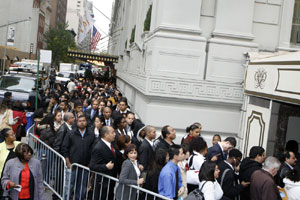|
Public meeting in Newark, New Jersey
Saturday, November 22
The Crisis has Barely Begun!
... and Workers' Fight to End the Wages System Is Posed (click here for ad)
|
|
(lead article)
Unemployment rises as production slows
Cities, states plan to slash social services

|
|
William Farrington
|
|
Nearly 1,000 people line up for an interview for one of 200 jobs outside Pierre Hotel in Manhattan November 7. Official unemployment rose in October to 6.5 percent.
|
BY BRIAN WILLIAMS
Hundreds of thousands of workers were thrown onto the unemployment rolls last month under the impact of declining production and trade, a feature of the worldwide financial crisis.
More than 18 million workers in the United States are without full-time jobs—10.1 million listed by the government as unemployed; 6.7 million who can only get part-time hours; and 1.6 million tagged as “marginally attached” or “discouraged” workers who the government claims are not searching for employment.
In October, the official unemployment rate jumped to 6.5 percent—up from 6.1 percent in September—the highest level since 1994. According to the U.S. Department of Labor, bosses eliminated 240,000 jobs last month. This is the 10th consecutive monthly decline, bringing job cuts for the year to 1.2 million. More than half of jobs eliminated this year were lost in the past three months.
Included in the government statistics are revised figures that sharply boosted the number of jobs slashed by bosses in August and September. The August figure was adjusted to 127,000 from the previously reported 73,000. In September, an announced 159,000 job cuts is now 284,000.
Jobs eliminated included 90,000 in manufacturing, 49,000 in construction, 38,000 retail jobs, and 50,000 for those working as “temporaries.” Only mining and health care showed job increases. The official unemployment rate for Hispanics was 8.8 percent, a 1 percent rise from the previous month; for Blacks it was 11.1 percent.
The so-called underemployment rate, which counts those the Department of Labor considers no longer looking for employment and those working part-time who can’t get full-time jobs, rose to 11.8 percent, up from 8.4 percent a year earlier.
According to Labor Department statistics, the total number receiving unemployment benefits as of the week ending October 25 rose to 3.8 million, the highest level in 25 years. Only 32 percent of those listed by the government as being out of work receive state benefit checks. More than 22 percent of unemployed workers have been out of work for six months.
Workers’ real wages continue to decline as prices rose for many basic necessities, especially food and fuel. In October average hourly wages increased by just 4 cents to $18.21. Over the past year workers’ weekly pay grew 2.9 percent, far below the official inflation rate of 4.9 percent, which doesn’t include rising food and fuel prices.
Bosses are also reducing hours. There was a 2.7 percent drop, measured over the course of a year, in hours worked during the third quarter, reported the Wall Street Journal.
“U.S. manufacturing activity fell in October at the fastest pace since the 1982 recession,” reported Investor’s Business Daily, noting also that it has “slowed sharply in China and hit a record low” among 15 European nations using the euro currency.
Slashing production
ArcelorMittal, the world’s largest steel company, announced November 5 that it is slashing production of flat carbon steel by more than 30 percent—more than double what the company announced in October. The company, with 326,000 employees in more than 60 countries, will temporarily idle 12 of its 28 European flat carbon blast furnaces with layoffs worldwide, said the company’s London spokesperson, Haroon Hassan.
Steel orders for construction and car production have fallen sharply. Prices of hot-rolled steel have fallen from about $800 a metric ton four weeks ago to around $700. Chief Executive Lakshmi Mittal said the company was running at nearly full capacity into the first part of September, but that demand plunged after the credit markets seized up later that month, according to the International Herald Tribune.
The auto barons at General Motors are demanding billions in a federal bailout to stave off bankruptcy. A GM spokesperson announced November 7 that the company could run out of cash early next year. GM also halted talks on taking over Chrysler.
In October, GM sales fell 45 percent from a year earlier while Chrysler was down 35 percent, Ford by 30 percent, and Toyota, 23 percent. Production is being cut at 10 GM factories and 5,600 workers are being laid off in the United States and Canada.
A study by the Center for Automotive Research said that if the Big Three U.S. auto makers—GM, Ford, and Chrysler—cut output by 50 percent, some 2.5 million jobs could also be cut in 2009.
Meanwhile, the federal government has expanded its bailout of insurance giant American International Group to $150 billion—nearly double the $85 billion given to the company in September. Fannie Mae, which together with Freddie Mac, was given a $200 billion government bailout in August, said it lost $29 billion in the third quarter and was nearly out of cash.
Circuit City, the country’s second largest electronics chain, filed for bankruptcy November 10, one week after announcing it would close 155 U.S. stores and lay off more than 7,000 employees— nearly 20 percent of its workforce. DHL is eliminating 9,500 jobs, discontinuing its U.S. domestic service.
New York governor David Paterson in his efforts to lower a reported $12.5 billion budget deficit, stated November 9 that cuts for education and health care programs will “unquestionably” be in the billions of dollars over the coming year. New York mayor Michael Bloomberg vowed to eliminate 3,000 city jobs and called for a 6 cents tax on each plastic bag shoppers need to carry their goods. Philadelphia mayor Michael Nutter is eliminating more than 2,500 full or part-time jobs and closing 11 libraries and 62 swimming pools.
| 


